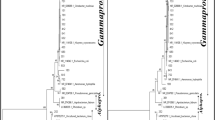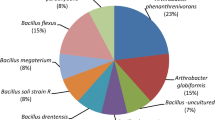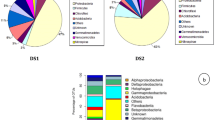Abstract
Twenty-two 2,4-dichlorophenoxyacetic acid (2,4-D)-degrading bacterial isolates were collected from agricultural soils at three sites in China. Sequence analysis of the 16S rRNA genes indicated that the isolates were phylogenetically grouped into four categories: Ochrobactrum anthropi, in the Alpha- class of the phylum Proteobacteria (3 out of 22 isolates), Cupriavidus sp., of the Betaproteobacteria (3 out of 22), Pseudomonas sp. and Stenotrophomonas sp., which are Gammaproteobacteria (7 out of 22), and Bacillus sp., of the phylum Firmicutes (9 out of 22). Primers were designed to amplify the conserved domain of tfdA, which is known to be involved in the degradation of 2,4-D. Results showed that the tfdA genes of all 22 strains were most similar to that of Cupriavidus necator JMP134, which belongs to the 2,4-D/α-ketoglutarate dioxygenase TfdA protein family, indicating that the JMP134-type tfdA gene is likely to be almost universal among the 2,4-D-degrading bacteria isolated from China. Degradation abilities of these 22 strains were investigated in assays using 2,4-D as the sole source of carbon and energy. Thirteen strains degraded >60 % of the available 2,4-D (500 mg l−1) over a 1-week incubation period, while a further nine Bacillus sp. strains degraded 50–81 % of the available 2,4-D. None of these nine strains degraded other selected herbicides, such as mecoprop, 2-methyl-4-chlorophenoxyacetic acid, quizalofop, and fluroxypyr. This is the first report of 2,4-D-degradation by Bacilli.





Similar content being viewed by others

Explore related subjects
Discover the latest articles and news from researchers in related subjects, suggested using machine learning.References
Bælum J, Jacobsen CS (2009) Taqman probe-based real-time PCR assay for detection and discrimination of class I, II, and III tfdA genes in soils treated with phenoxy acid herbicides. Appl Environ Microbiol 75(9):2969–2972
Bælum J, Henriksen T, Hansen HCB, Jacobsen CS (2006) Degradation of 4-chloro-2-methylphenoxyacetic acid in top- and subsoil is quantitatively linked to the class III tfdA gene. Appl Environ Microbiol 72(2):1476–1486
Bælum J, Nicolaisen MH, Holben WE, Strobel BW, Sørensen J, Jacobesen CS (2008) Direct analysis of tfdA gene expression by indigenous bacteria in phenoxy acid amended agricultural soil. ISME J 2(6):677–687
Bælum J, Jacobsen CS, Holben WE (2010) Comparison of 16S rRNA gene phylogeny and functional tfdA gene distribution in thirty-one different 2,4-dichlorophenoxyacetic acid and 4-chloro-2-methylphenoxyacetic acid degraders. Syst Appl Microbiol 33(2):67–70
Boyce R, Chilana P, Rose TM (2009) iCODEHOP: a new interactive program for designing COnsensus-DEgenerate Hybrid Oligonucleotide Primers from multiply aligned protein sequences. Nucleic Acids Res 1–7. doi: 10.1093/nar/gkp379
Cycoń M, Zmijowska A, Piotrowska-Seget Z (2011) Biodegradation kinetics of 2,4-D by bacterial strains isolated from soil. Cent Eur J Biol 6:188–198
Dunbar J, Wong DCL, Yarus MJ, Forney LJ (1997) Genetic diversity through the looking glass: effect of enrichment bias. Appl Environ Microbiol 63(4):1326–1331
Fukumori F, Hausinger RP (1993a) Purification and characterization of 2,4-dichlorophenoxyacetate/α-ketoglutarate dioxygenase. J Biol Chem 268(32):24311–24317
Fukumori F, Hausinger RP (1993b) Alcaligenes eutrophus JMP134 “2,4-dichlorophenoxyacetate monooxygenase” is an α-ketoglutarate-dependent dioxygenase. J Bacteriol 175(7):2083–2086
Fulthorpe RR, McGowan C, Maltseva OV, Holben WE, Tiedje JM (1995) 2,4-Dichlorophenoxyacetic acid-degrading bacteria contain mosaics of catabolic genes. Appl Environ Microbiol 61(9):3274–3281
Gonod LV, Martin-Laurent F, Chenu C (2006) 2,4-D impact on bacterial communities, and the activity and genetic potential of 2,4-D degrading communities in soil. FEMS Microbiol Ecol 58(3):529–537
Hogan DA, Buckley DH, Nakatsu CH, Schmidt TM, Hausinger RP (1997) Distribution of the tfdA gene in soil bacteria that do not degrade 2,4-dichlorophenoxyacetic acid (2,4-D). Microb Ecol 34(2):90–96
Itoh K, Kanda R, Momoda Y, Sumita Y, Kamagata Y, Suyama K, Yamamoto H (2000) Presence of 2,4-D-catabolizing bacteria in a Japanese arable soil that belong to BANA (Bradyrhizobium-Agromonas-Nitrobacter-Afipia) cluster in α-Proteobacteria. Microbes Environ 15(2):113–117
Itoh K, Kanda R, Sumita Y, Kim H, Kamagata Y, Suyama K, Yamamoto H, Hausinger RP, Tiedje JM (2002) tfdA-like genes in 2,4-dichlorophenoxyacetic acid-degrading bacteria belonging to the Bradyrhizobium-Agromonas-Nitrobacter-Afipia cluster in α-Proteobacteria. Appl Environ Microbiol 68(7):3449–3454
Itoh K, Tashiro Y, Uobe K, Kamagata Y, Suyama K, Yamamoto H (2004) Root nodule Bradyrhizobium spp. harbor tfdA alpha and cadA, homologous with genes encoding 2,4-dichlorophenoxyacetic acid-degrading proteins. Appl Environ Microbiol 70:2110–2118
Ka JO, Tiedje JM (1994) Integration and excision of a 2,4-dichlorophenoxyacetic acid-degradative plasmid in Alcaligenes paradoxus and evidence of its natural intergenetic transfer. J Bacteriol 176(17):5284–5289
Ka JO, Holben WE, Tiedje JM (1994) Genetic and phenotypic diversity of 2,4-dichlorophenoxyacetic acid (2,4-D)-degrading bacteria isolated from 2,4-D-treated field soils. Appl Environ Microbiol 60(4):1106–1115
Kamagata Y, Fulthorpe RR, Tamura K, Takami H, Formey LJ, Tiedje JM (1997) Pristine environments harbour a new group of oligotrophic 2,4-dichlorophenoxyacetic acid-degrading bacteria. Appl Environ Microbiol 63(6):2266–2272
Kim OS, Cho YJ, Lee K, Yoon SH, Kim M, Na H, Park SC, Jeon YS, Lee JH, Yi H, Won S, Chun J (2012) Introducing EzTaxon-e: a prokaryotic 16S rRNA gene sequence database with phylotypes that represent uncultured species. Int J Syst Evol Microbiol 62(3):716–721
Kim DU, Kim MS, Lim JS, Ka JO (2013) Widespread occurrence of the tfd-II genes in soil bacteria revealed by nucleotide sequence analysis of 2,4-dichlorophenoxyacetic acid degradative plasmids pDB1 and p712. Plasmid 69(3):243–248
Kitagawa W, Takam S, Miyauchi K, Masai E, Kamagata Y, Tiedje JM (2002) Novel 2,4-dichlorophenoxyacetic acid degradation genes from oligotrophic Bradyrhizobium sp. strain HW13 isolated from a pristine environment. J Bacteriol 184:509–518
Knauer SH, Hartl-Spiegelhauer O, Schwarzinger S, Hänzelmann P, Dobbek H (2012) The Fe(II)/α-ketoglutarate-dependent taurine dioxygenases from Pseudomonas putida and Escherichia coli are tetramers. FEBS J 279(5):816–831
Laemmli CM, Leveau JHJ, Zehnder AJB, van der Meer JR (2000) Characterization of a second tfd gene cluster for chlorophenol and chlorocatechol metabolism on plasmid pJP4 in Ralstonia eutropha JMP134 (pJP4). J Bacteriol 182(15):4165–4172
Larkin MA, Blackshields G, Brown NP, Chenna R, McGettigan PA, McWilliam H, Valentin F, Wallace IM, Wilm A, Lopez R, Thompson JD, Gibson TJ, Higgins DG (2007) Clustal W and clustal X version 2.0. Bioinformatics 23(21):2947–2948
Lee TH, Kurata S, Nakatsu CH, Kamagata Y (2005) Molecular analysis of bacterial community based on 16S rDNA and functional genes in activated sludge enriched with 2,4-dichlorophenoxyacetic acid (2,4-D) under different cultural conditions. Microb Ecol 49(1):151–162
Lerch TZ, Dignac MF, Barriuso E, Bardoux G, Mariotti A (2007) Tracing 2,4-D metabolism in Cupriavidus necator JMP134 with 13C-labelling technique and fatty acid profiling. J Microbiol Methods 71:162–174
Macur RE, Wheeler JT, Burr MD, Inskeep WP (2007) Impacts of 2,4-D application on soil microbial community and on populations associated with 2,4-D degradation. Microbiol Res 162(1):37–45
McGowan C, Fulthorpe R, Wright A, Tiedje JM (1998) Evidence for interspecies gene transfer in the evolution of 2,4-dichlorophenoxyacetic acid degraders. Appl Environ Microbiol 64(10):4089–4092
Müller RH, Jorks S, Kleinsteuber S, Babel W (1998) Degradation of various chlorophenols under alkaline conditions by gram-negative bacteria closely related to Ochrobactrum anthropi. J Basic Microb 38(4):269–281
Rodriguez-Cruz MS, Bælum J, Shaw LJ, Sorensen SR, Shi SJ, Aspray TJ, Jacobsen CS, Bending GD (2010) Biodegradation of the herbicide mecoprop-p with soil depth and its relationship with class III tfdA genes. Soil Biol Biochem 42(1):32–39
Rose TM, Schultz ER, Henikoff JG, Pietrokovski S, McCallum CM, Henikoff S (1998) Consensus-degenerate hybrid oligonucleotide primers for amplification of distantly related sequences. Nucleic Acids Res 26(7):1628–1635
Rose TM, Henikoff JG, Henikoff S (2003) CODEHOP (COnsensus-DEgenerate Hybrid Oligonucleotide Primer) PCR primer design. Nucleic Acids Res 31(13):3763–3766
Shaw L, Burns RG (2004) Enhanced mineralization of [U-14C]2,4-dichlorophenoxyacetic acid in soil from the rhizosphere of Trifolium pretense. Appl Environ Microbiol 70(8):4766–4774
Shimojo M, Kawakami M, Aamda K (2009) Analysis of genes encoding the 2,4-dichlorophenoxyacetic acid-degrading enzyme from Sphingomonas agrestis 58-1. J Biosci Bioeng 108:56–59
Smejkal CW, Vallaeys T, Seymour FA, Burton SK, Lappin-Scott HM (2001a) Characterization of (R/S)-mecoprop [2-(2-methyl-4-chlorophenoxy)propionic acid]-degrading Alcaligenes sp. CS1 and Ralstonia sp. CS2 isolated from agricultural soils. Environ Microbiol 3(4):288–293
Smejkal CW, Vallaeys T, Burton SK, Lappin-Scott HM (2001b) A rapid method to screen degradation ability in chlorophenoxyalkanoic acid herbicide-degrading bacteria. Lett Appl Microbiol 32(4):273–277
Smejkal CW, Seymour FA, Burton SK, Lappin-Scott HM (2003) Characterisation of bacterial cultures enriched on the chlorophenoxyalkanoic acid herbicides 4-(2,4-dichlorophenoxy) butyric acid and 4-(4-chloro-2-methylphenoxy) butyric acid. J Ind Microbiol Biotechnol 30(9):561–567
Sota M, Yano H, Naqata Y, Ohtsubo Y, Genka H, Kawasaki H, Tsuda M (2006) Functional analysis of unique class II insertion sequence IS1071. Appl Environ Microbiol 72(1):291–297
Streber WR, Timmis KN, Zenk MH (1987) Analysis, cloning, and high-level expression of 2,4-dichlorophenoxyacetate monooxygenase gene tfdA of Alcaligenes eutrophus JMP134. J Bacteriol 169(7):2950–2955
Suwa Y, Wright AD, Fukimori F, Nummy KA, Hausinger RP, Holben WE, Forney LJ (1996) Characterization of a chromosomally encoded 2,4-dichlorophenoxyacetic acid/α-ketoglutarate dioxygenase from Burkholderia sp. strain RASC. Appl Environ Microbiol 62(7):2464–2469
Tamura K, Peterson D, Peterson N, Stecher G, Nei M, Kumar S (2011) MEGA5: molecular evolutionary genetics analysis using maximum likelihood, evolutionary distance, and maximum parsimony methods. Mol Biol Evol 28(10):2731–2739
Top EM, Holben WE, Forney LJ (1995) Characterization of diverse 2,4-dichlorophenoxyacetic acid-degradative plasmids isolated from soil by complementation. Appl Environ Microbiol 61(5):1691–1698
Vallaeys T, Fulthrope RR, Wright AM, Soulas G (1996) The metabolic pathway of 2,4-dichlorophenoxyacetic acid degradation involves different families of tfdA and tfdB genes according to PCR-RFLP analysis. FEMS Microbiol Ecol 20(3):163–172
Vallaeys T, Albino L, Soulas G, Wright AD, Weightman AJ (1998) Isolation and characterization of a stable 2,4-dichlorophenoxyacetic acid degrading bacterium, Variovorax paradoxus, using chemostat culture. Biotechnol Lett 20(11):1073–1076
Vedler E, Kὂiv V, Heinaru A (2000) Analysis of the 2,4-dichlorophenoxyacetic acid-degradative plasmid pEST4011 of Achromobacter xylosoxidans subsp. denitrificans strain EST4002. Gene 255(2):281–288
Zabaloy MC, Gómez MA (2013) Isolation and characterization of indigenous 2,4-D herbicide degrading bacteria from an agricultural soil in proximity of Sauce Grande River, Argentina. Ann Microbiol. doi:10.1007/s13213-013-0731-9
Zakaria D, Lappin-Scott H, Burton S, Whitby C (2007) Bacterial diversity in soil enrichment cultures amended with 2-(2-methyl-4-chlorophenoxy)propionic acid (mecoprop). Environ Microbiol 9(10):2575–2587
Acknowledgments
This work was supported by a Transgenic Major Project (2011ZX08010-003) from China’s Ministry of Agriculture and Nature Science Foundation Project J [2013] 2123 of Guizhou Province, China.
Author information
Authors and Affiliations
Corresponding author
Rights and permissions
About this article
Cite this article
Han, L., Liu, Y., He, A. et al. 16S rRNA gene phylogeny and tfdA gene analysis of 2,4-D-degrading bacteria isolated in China. World J Microbiol Biotechnol 30, 2567–2576 (2014). https://doi.org/10.1007/s11274-014-1680-6
Received:
Accepted:
Published:
Issue Date:
DOI: https://doi.org/10.1007/s11274-014-1680-6



